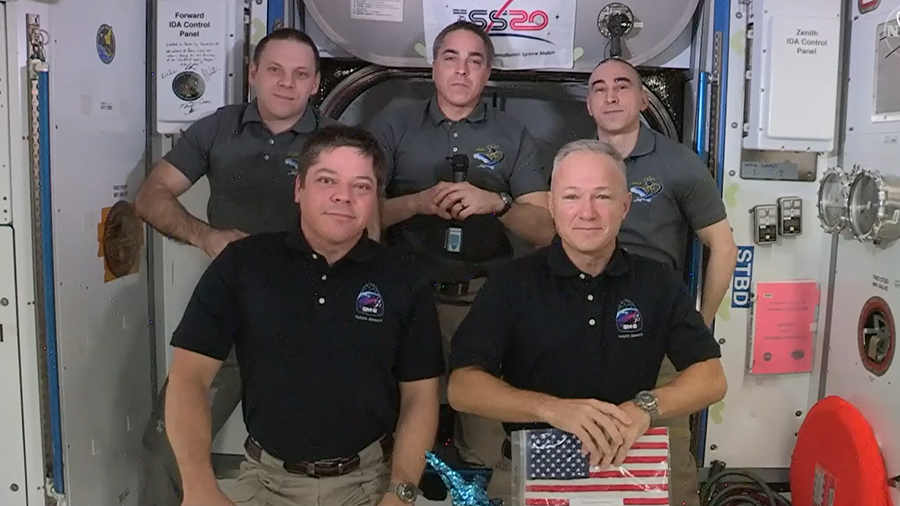NASA, SpaceX Proceed Toward Crew Dragon Splashdown

Teams from NASA and SpaceX are proceeding with preparations to bring NASA astronauts Robert Behnken and Douglas Hurley home from the International Space Station to Earth with a splashdown on Sunday, Aug. 2, off the Florida coast aboard the SpaceX Crew Dragon “Endeavour” spacecraft.
Watch the crew farewell ceremony on YouTube.
Return conditions remained “Go” at several of the needed target locations for splashdown and recovery after teams received a weather briefing Friday evening from the U.S. Air Force 45th Weather Squadron. NASA and SpaceX will make a decision on a primary splashdown target approximately 6 hours before undocking.
NASA and SpaceX are targeting 7:34 p.m. EDT Saturday, Aug. 1, for undocking of the Dragon “Endeavour” spacecraft from the space station and 2:42 p.m. Sunday, Aug. 2, for splashdown, which will be the first return of a commercially built and operated American spacecraft carrying astronauts from the space station.
Teams continue to closely monitor Hurricane Isaias and evaluate impacts to the landing sites in the Gulf of Mexico along the Florida Panhandle. Teams have several weather decision milestones ahead of and after undocking to adjust the splashdown location and time based on the forecasted conditions for recovery.
NASA’s SpaceX Demo-2 return coverage is as follows (all times Eastern):
Saturday, Aug. 1
- 5:15 p.m. – NASA TV undocking coverage begins for the 7:34 p.m. undocking (NASA Television will have continuous coverage from undocking to splashdown)
Sunday, Aug. 2
- 2:42 p.m. – Splashdown
- 5 p.m. – Administrator post-splashdown news conference at Johnson, with the following representatives:
- NASA Administrator Jim Bridenstine
- Commercial Crew Program representative
- International Space Station representative
- Gwynne Shotwell, president and chief operating officer, SpaceX
- NASA Astronaut Office representative
Tuesday, Aug. 4
- 4:30 p.m. – Demo-2 Crew News Conference from the Johnson Space Center, with the following participants
- NASA astronaut Bob Behnken
- NASA astronaut Doug Hurley
Behnken and Hurley arrived at the orbiting laboratory on May 31, following a successful launch on May 30 on a SpaceX Falcon 9 rocket from NASA’s Kennedy Space Center in Florida. During their 63 days aboard station, Behnken and Hurley contributed more than 100 hours of time to supporting the orbiting laboratory’s investigations, participated in public engagement events, and supported four spacewalks with Behnken and Cassidy to install new batteries in the station’s power grid and upgrade other station hardware.
These activities are a part of NASA’s Commercial Crew Program, which has been working with the U.S. aerospace industry to launch astronauts on American rockets and spacecraft from American soil the International Space Station for the first time since 2011. This is SpaceX’s final test flight and is providing data on the performance of the Falcon 9 rocket, Crew Dragon spacecraft and ground systems, as well as in-orbit, docking, splashdown and recovery operations.
The test flight also is helping NASA certify SpaceX’s crew transportation system for regular flights carrying astronauts to and from the space station. SpaceX is readying the hardware for the first rotational mission, which would occur following NASA certification.
The goal of NASA’s Commercial Crew Program is safe, reliable and cost-effective transportation to and from the International Space Station. This could allow for additional research time and increase the opportunity for discovery aboard humanity’s testbed for exploration, including helping us prepare for human exploration of the Moon and Mars.
More details about the mission and NASA’s commercial crew program can be found in the press kit online and by following the commercial crew blog, @commercial_crew and commercial crew on Facebook.
Learn more about station activities by following @space_station and @ISS_Research
on Twitter as well as the ISS Facebook and ISS Instagram accounts.
Mark Garcia
Powered by WPeMatico



